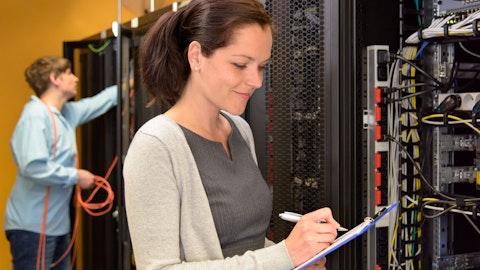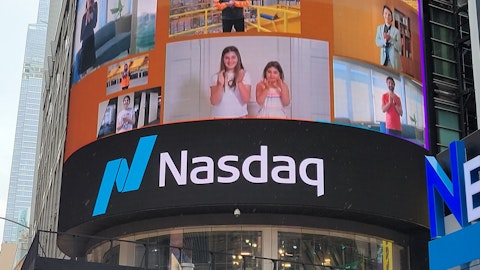Dan Newman: That’s right. Maybe I’ll just take this opportunity just to give some statistics about churn. We talk about it in terms of square meters of area utilized. It’s easier to track it that way. We think that our normal churn rate going forward will be around 4% of area utilized, maybe 4% to 5%, which I believe is low by global benchmarks. In past years, it was 2% to 3%. But given the evolution of our business, it’s natural. I think to expect that to be higher. In the current year, I think the total churn will be around 28,000 to 29,000 square meters, which is around 7.5%. So it’s clearly higher, and the difference is what we call exceptional churn, the redeployment is actually the majority of that. Yeah, this will happen from time to time.
And it could set us back in the short term, it can affect our growth rate by a small amount. But as it so happens, the redeploying customer has placed new orders with us, which are 1.5x the amount which the terminated. So effect, it’s one step back in 1.5 steps forward, albeit with a timing difference. But hopefully, that will be complete, and we will hopefully revert to just described as a normal level of churn.
Yang Liu: Okay. Thank you.
Operator: Thank you. Now we’re going to take our next question. Just give us a moment. And the next question comes from the line of Frank Louthan from Raymond James. Your line is open. Please ask your question.
Unidentified Analyst: Hey guys, good morning. This is Rob on for Frank. Are you seeing any demand for liquid cooling-based servers? And if so, who pays the extra capital costs required for that. Do you guys pay it and adjust the pricing? Or does the customer contribute some capital? Thank you.
William Huang: Yeah. I think we are — as I just mentioned, we deployed the — it’s not — first of all, I think the liquid cooling was already deployed a couple of years ago in China already, right? We are very familiar with this technology. So we also — I just mentioned, we are deploying our NTP1, right? So our customers also require for liquid cooling. So during the future, I think for the AI guide, these are very normal, and — but not everybody — every AI customer use liquid cooling. It depends, the different — the customer has a different required profile. But number one, we are very familiar with that. Number two, I think the cost — in terms of cost, it’s — in our view, it’s not significantly different, right, than the what we built before for the normal case, right?
So I think the — of course, costs increase, we definitely will charge from our customer, which we already got in a mutual agreement with our customer. So this will not impact any of our return.
Operator: Thank you. Now we’re going to take our next question. Just a moment. And the next question comes from the line of Sara Wang from UBS. Your line is open. Please ask your question.
Sara Wang: Thank you for the opportunity. I have a question on overseas business, especially for the Johor campus, besides China customers, shall we expect meaningful new orders from either international customers, cloud customers or local customers? It’s actually given there are a lot of other data center operators announced a meaningful pipeline in the region. So how shall we think about the competition landscape going forward? Thank you.
William Huang: So number one, we are targeting all kind of customers. Our sales team working on domestic demand, international demand and also China demand. So we don’t care who’s customer, customer is a customer, right? So I think the — but we believe our Johor campus, two campuses including new future campus KTP, we definitely — we are confident to get the combination of the customer just like what we did in Hong Kong already, right? So I think this will not be the issue. We will not just specifically target one kind of customer. We target all, right? So we believe GDS sales and our product will welcome by the all kind of customers as well. So in terms of the competition, I think we’re competing with everybody in China for 22 years.
We don’t afraid of competition, which we like the competition. I think GDS will grow — we will grow from a lot of the competitors, right? So I think it’s good. And that’s why if you — we already demonstrated even in a very, very competitive market in China in the last 20 years, we’re getting number one position, right? This is a win already — so we are not thinking about what’s our competitor doing, whether they can do everything, but we believe we will win in every market.
Sara Wang: Got it. And then is there any additional color on the gross new bookings for next year, should may be higher than this year, especially given the Johor campus continue to ramp up?
William Huang: You mean in international market? May be overall?
Sara Wang: Yeah, overall, and then maybe there’s additional color on overseas contribution. Yeah.
Dan Newman: So we take this in two parts, right. For China over quite a few quarters now, we’ve made it clear that we’re not targeting a high sales volume. We’re targeting a particular kind of business, which matches the inventory that we have, where there’s a fixed moving schedule faster than what we’ve experienced before and of course, reasonable pricing. So we do any amount of business that meets those criteria. We don’t forecast any change in China market conditions, our own internal business plan just assumes continuation of the current run rate. We’re not crystal ball gazers. So we don’t build in any kind of assumptions about the change in market conditions. But of course, we are very well positioned to respond to any change.




